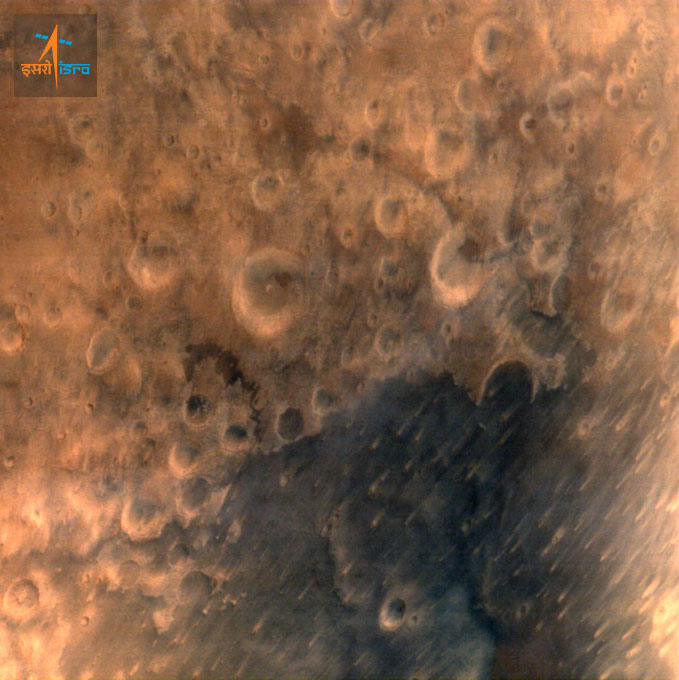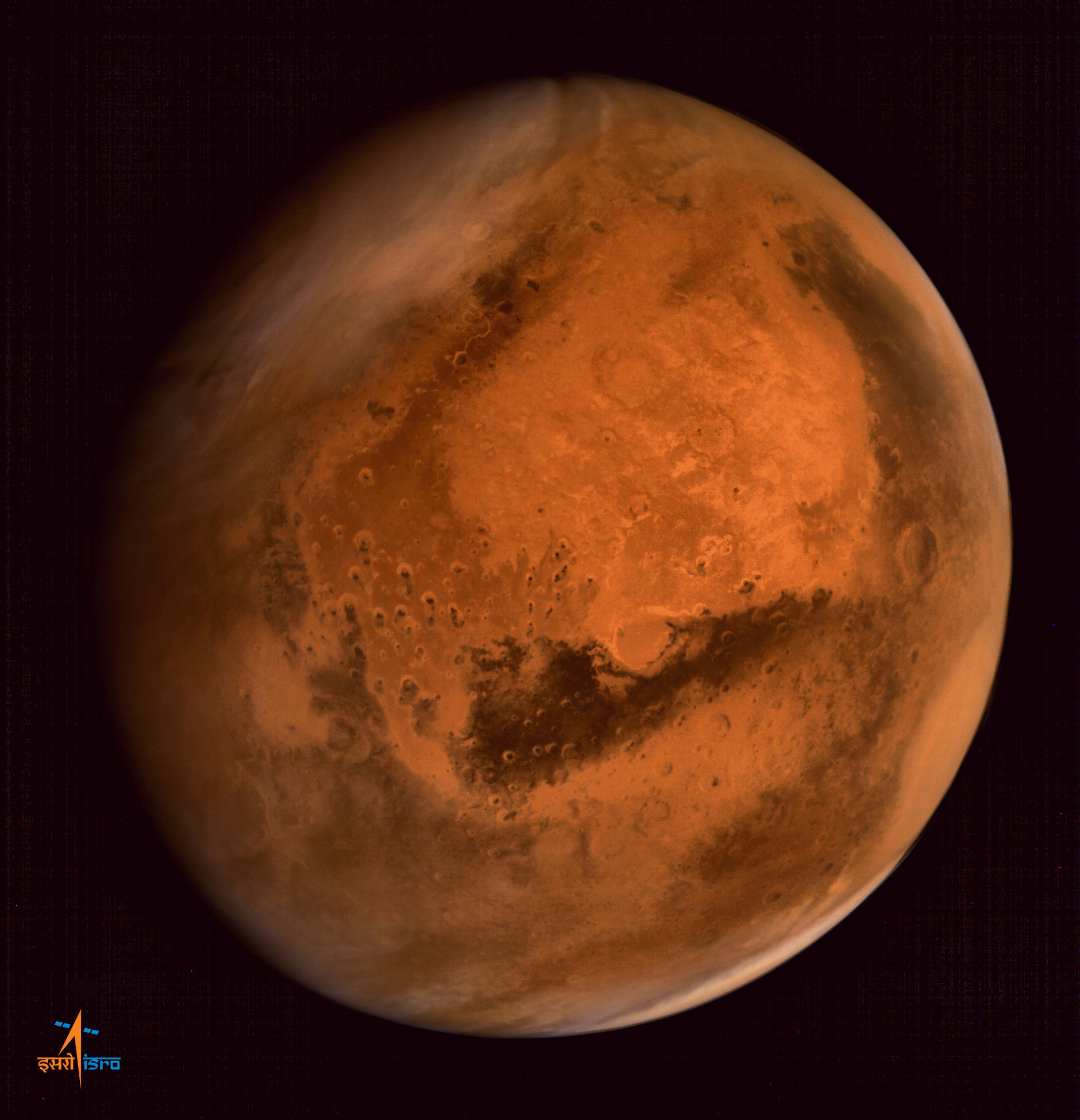
Earth’s invasion fleet at the Red Planet now stands at a record breaking seven spacecraft following the successful arrival of a new pair of probes from the US and India in late September 2014.
NASA’s newest Mars mission, the Mars Atmosphere and Volatile Evolution (MAVEN) spacecraft successfully entered orbit around the Red Planet on Sept. 21, 2014 at 10:24 p.m. EDT, to conduct the first detailed study of the planets tenuous upper atmosphere and unlock mysteries on its habitability. The MAVEN spacecraft completed the crucial Mars Orbit Insertion (MOI) maneuver after firing its six braking thrusters for approximately 34 minutes and 26 seconds.
Space history was made again two days later when India’s car sized Mars Orbiter Mission (MOM) successfully fired its braking rockets and arrived in Mars orbit on Sept. 23 EST/Sept. 24 IST on the nation’s first attempt to explore the Red Planet. Indeed MOM is India’s maiden interplanetary voyager ever.
MAVEN
“You only get one shot at Mars Orbit Insertion and we nailed it,” said David Mitchell, MAVEN project manager from NASA’s Goddard Space Flight Center, Greenbelt, Maryland, at a post MOI media briefing at the Lockheed Martin operations center in Littleton, Colorado, where the spacecraft was built. “It was about 11 seconds longer than planned. My thanks to all who worked so hard on this project.”
“A post MOI assessment indicated we are in a stable capture orbit of approximately 35 hour duration. Five additional burns will reduce that to the planned 4.5 hour science mapping orbit,” Mitchell noted.

MAVEN arrived after a trouble free and fantastic 10-month interplanetary voyage of 442 million miles from Earth to the Red Planet.
“As the first orbiter dedicated to studying Mars’ upper atmosphere, MAVEN will greatly improve our understanding of the history of the Martian atmosphere, how the climate has changed over time, and how that has influenced the evolution of the surface and the potential habitability of the planet,” said NASA Administrator Charles Bolden, in a statement. “It also will better inform a future mission to send humans to the Red Planet in the 2030s.”
NASA is currently building the Orion crew spacecraft and SLS rocket to send humans on deep space destinations to Asteroids and Mars.
MAVEN joined an armada of five spacecraft already exploring Mars in great detail but with different science goals.
“NASA has a long history of scientific discovery at Mars and the safe arrival of MAVEN opens another chapter,” said John Grunsfeld, astronaut and associate administrator of the NASA Science Mission Directorate at the agency’s Headquarters in Washington. “Maven will complement NASA’s other Martian robotic explorers—and those of our partners around the globe—to answer some fundamental questions about Mars and life beyond Earth.”
“Stepping back and thinking what this represents it amazing to think about what has been accomplished,” Grunsfeld said at the briefing.
“We are now in orbit at Mars after 11 years of hard work,” said Bruce Jakosky, MAVEN principal investigator with the Laboratory for Atmospheric and Space Physics at the University of Colorado, Boulder (CU/LASP), gleefully at the briefing.
“My heart is about ready to start again. We had an absolutely flawless performance tonight. Over the next six weeks we will do the commissioning work to prepare the spacecraft for its science mission. Four booms need to be deployed and one cap needs to be broken off.”
“Early November is the official start of the science mission. But we’ll have five days of bonus science with the unexpected flyby of Comet Siding Spring in mid-October.”
The primary mission includes five “deep-dip” campaigns, in which MAVEN’s periapsis, or lowest orbit altitude, will be lowered from 93 miles (150 kilometers) to about 77 miles (125 kilometers). These measurements will provide information down to where the upper and lower atmospheres meet, giving scientists a full profile of the upper tier.

MAVEN will investigate Mars transition from its ancient, water-covered past, to the cold, dry, dusty world that it has become today. It is NASA’s first orbiter specifically dedicate to investigate the planets thin upper atmosphere and begin solving the riddles of Mars’ climate mysteries, atmospheric and water loss and habitability.
“Where did the water go and where did the carbon dioxide go from the early atmosphere? What were the mechanisms?” notes Jakosky.
The 5,400 pound MAVEN probe carries nine sensors in three instrument suites to study why and exactly when did Mars undergo the radical climatic transformation.
“I’m really looking forward to getting to Mars and starting our science!” Jakosky said recently.
MAVEN thundered to space on Nov. 18, 2013 following a flawless blastoff from Cape Canaveral Air Force Station’s Space Launch Complex 41 atop a powerful Atlas V rocket and thus began a 10 month interplanetary voyage from Earth to the Red Planet.
MOM
With MOM’s orbital insertion at the Red Planet, India joined an elite club of only three other entities who have launched probes that successfully investigated Mars – following the Soviet Union, the United States and the European Space Agency (ESA).
Wild applause erupted with beaming smiles from ear to ear at India’s Bangalore mission control center after signals confirming a successful full duration firing of the crafts engines for 24 minutes and 13 seconds for the crucial Mars Orbital Insertion (MOI) maneuver that placed MOM into orbit, were received precisely as planned at 10:30 p.m. EDT (Sept. 23) or 8:00 IST (Sept. 24).
Traveling at the speed of light it took nearly 12.5 minutes for the good news signals to arrive on Earth from Mars across the vast expanse of some 140 million miles (225 million kilometers) of interplanetary space.

MOM’s Red Planet arrival was webcast live worldwide by the Indian Space Research Organization (ISRO), India’s space agency which designed and developed the orbiter. ISRO’s website also gave a play by play in real time, announcing the results of critical spacecraft actions along the arrival timeline just moments after they became known to the engineers.
The do-or-die MOI breaking maneuver slowed MOM’s velocity by 1099 m/s (2457 mph) vs. an expected 1098.7 m/s – using the combined thrust of the 440 Newton Liquid Apogee Motor (LAM) main engine and eight smaller 22 newton liquid fueled engines.
The entire MOI maneuver took place fully autonomously under the spacecrafts preprogrammed sole control due to the long communications lag time and also during a partial communications blackout when the probe was traveling behind Mars and the signal was blocked.

“India has successfully reached Mars!” declared Indian prime minister Narendra Modi, who watched the events unfold from mission control at ISRO’s Telemetry, Tracking and Command Network (ISTRAC) in Bangalore.
“History has been created today. We have dared to reach out into the unknown and have achieved the near-impossible. I congratulate all ISRO scientists as well as all my fellow Indians on this historic occasion.”
Modi gave a stirring and passionate speech to the team, the nation and a global audience outlining the benefits and importance of India’s space program. He implored the team to strive for even greater space exploration challenges, sounding very much like US President John F. Kennedy over 50 years ago!
“We have gone beyond the boundaries of human enterprise and imagination,” Modi stated. “We have accurately navigated our spacecraft through a route known to very few. And we have done it from a distance so large that it took even a command signal from Earth to reach it more than it takes sunlight to reach us.”

MOM’s goal is to study Mars surface features, morphology, mineralogy and the Martian atmosphere with five indigenous scientific instruments. Among other goals it will sniff for methane as a potential marker for biological activity.
“We have prevailed. We have succeeded on our first attempt. We put together the spacecraft in record time, in a mere three years from first studying its feasibility,” Modi elaborated.
“These are accomplishments that will go down in history. Innovation by its very nature involves risk. It is a leap into the dark .. . and the unknown. Space is indeed the biggest unknown out there. Through your brilliance and hard work [at ISRO] you have made a habit of accomplishing the impossible.”
“The success of our space program is a shining symbol of what we are capable of as a nation. Our space program is an example of achievement which inspires us all .. and future generations … to strive for excellence ourselves.”

On her over 10 month interplanetary voyage, MOM crossed an interplanetary gulf of some 442 million miles (712 million km) from Earth to the Red Planet. MOM was launched on Nov. 5, 2013 from India’s spaceport at the Satish Dhawan Space Centre, Sriharikota, atop the nations indigenous four stage Polar Satellite Launch Vehicle (PSLV).
MOM and MAVEN join Earth’s newly fortified armada of seven spacecraft currently operating on Mars surface or in orbit – including Mars Odyssey (MO), Mars Reconnaissance Orbiter (MRO), Mars Express (MEX), Curiosity and Opportunity.
Scientists from MAVEN, Curiosity, Opportunity and all the orbiters will work in concert utilizing all the data to elucidate the history of Mars potential for supporting life – past and present.
Both MAVEN and MOM have already transmitted their first scientific results and images amidst all the work of their commissioning phases, indicating that both probes and all the scientific instruments and healthy and functioning properly. We’ll detail their ongoing Red Planet research and close encounter with Comet Siding Spring on Oct 19, 2014, in future issues of RocketSTEM.



